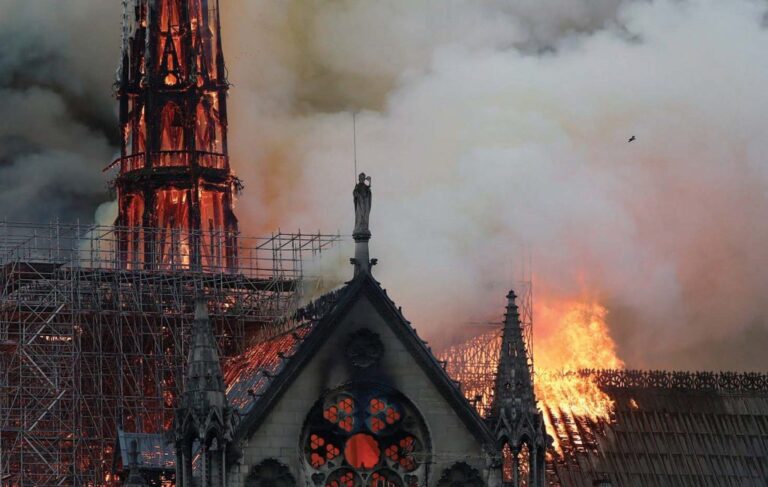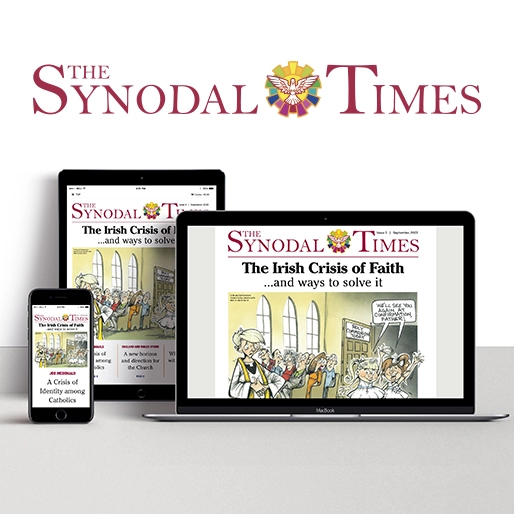I was in Rome recently at the launch of Mary McAleese’s book ‘The 17 Irish Martyrs’; Mary was part of a small group of historians and academics that whittled down hundreds of cases of Irish martyrs to the 17 that Pope John Paul II beatified as a representative group in 1992.
There are many more worthy cases that will hopefully make it to Rome sometime. The launch was held in the Irish College which always has a warm welcome for the Irish even if there are no Irish seminarians there anymore. But there are lots of young men, studying for other dioceses around the world.
In the college chapel, dedicated to the saints of Ireland, three of the nine figures represented in the apse are past students: St Oliver Plunkett, Blessed Columba Marmion and Father Ragheed Ganni.
Father Ragheed Ganni is featured on the extreme right of St Brigid. He is depicted without a halo but holding the palms of martyrdom. Chaldean Fr Ragheed Ganni, was killed by armed gunmen after celebrating Mass in Mosul Iraq on June 3, 2007, along with three deacons, including his cousin Deacon Basman Yousef Daud.
Threats
The deacons had been accompanying Fr Ganni because of increasing threats against him by militants. After shooting the men, the militants booby-trapped their car with explosives to prevent others from safely recovering the bodies.
The Vatican has given permission for the opening of the sainthood cause for the Iraqi priest who studied in the Irish College at Rome and spent several summers working at Lough Derg.
Interestingly, both Mary McAleese and Bishop Paul Tighe (who gave the excellent introductory remarks at the launch) recalled meeting Fr Ganni in Lough Derg in very ordinary and human terms. We walk among saints so we better tread carefully was the take-away.
I was staying in the ancient roman quarter of Trastevere, where Peter and the first Christians are believed to have stayed as did St Francis of Assisi when he came to Rome. It is also the home of The Sant’Egidio Community, founded by historian Andrea Riccardi in 1968.
The Community made a name for itself in its outreach to the poor, elderly and handicapped and had some success in international peace making. As a college student I was part of its short-lived Dublin branch and every Easter we came to Rome to join young people from around the world to listen to talks by Riccardi and his committed band of followers and its highlights were strolling around Trastevere with an ice cream or attending the community’s prayer service in the wonderful Byzantine styled church of Santa Maria in Trastevere.
Community
While the community grew new communities around the world, it didn’t take in Dublin, Ireland. Bishop Paul Tighe speculated at the book launch that perhaps Irish people don’t do the cult of leadership in the same way other nationalities do. Trying to transplant an Italian way of doing things in Ireland may not be the best approach. Our relationship to authority is more complex.
In a recent interview with La Croix newspaper, the 72 year-old Riccardi was asked how the Catholic Church can still remain credible in society given its history of sexual abuse especially in France as revealed by the Independent Commission on Sexual Abuse in the Church (CIASE) committed in the Church in France since 1950. It’s a question all of us need to answer if we are serious about engaging people who have fallen away from the Church or young people who have walked away shocked and horrified by the abuse scandals.
Riccardi answered: “The credibility of the Church has been questioned several times in contemporary history. It has been reproached for being on the side of the rich and the employers, far from the poor and the workers; close to Vichy in France and not to the Resistance, silent on the deportation of the Jews… I could go on and on. But there is a deeper crisis of which the sexual abuse crisis is a sad aspect, a global phenomenon that I really felt the night of the Notre Dame fire.
“It wasn’t just the monument that was burning, but the entire Church. And it was significant that this happened in Paris and in France, which have been the historical laboratory for an encounter between the Catholic Church and modernity. Vatican II owes an enormous debt to French Catholicism… and yet it was in France that the Church was burning.
“What are the causes of this crisis? The answer is not simple. But the Church’s illness is not only a Catholic affair. This is a crisis of Christianity, of secular society. It’s a European phenomenon, marked by different symptoms from one country to another.
“In Italy, it’s the disappearance of Christian democracy; in Spain, the brutal passage from a Catholicism linked to Franco’s authoritarian regime to secularisation; in Germany, the sexual abuse scandals, but also the synodal path, which calls into question certain Vatican positions.
Rupture
“I also wonder about the rupture in the transmission of memory. You will tell me that the traditionalists have responded to this, but it is the minority, sectarian response of a small Church nostalgic for a recreated past”.
Riccardi goes on to say that Vatican II was steeped in history but our time has lost its sense of history. He adds that Pope Francis has brought back the lesson that we must live in history to map a future – and Riccardi refuses to believe that the future for the west and the Church in the west is just decline.
He says: “In European culture, people have been talking about the decline of the west for years, and it has become a manner of living or surviving. I think there is a link between the European decline and the crisis of the Church.
“Look at the election of Jorge Bergoglio: his witness as a Latin American Catholic was a shock. Ratzinger symbolised the European crisis and the crisis of the Church together, while Bergoglio embodies the energy of a Catholicism that was not tied to Europe.
“I do not neglect the years of John Paul II. It is said that his pontificate was a marathon of a quarter of a century and that with his personality he covered up, basically, the weaknesses of the Church.
“Wojtyla was not an illusion. He exercised a charismatic government. To be Pope, one must be charismatic. Ratzinger was not, and he resigned, apparently with good reason. Francis, on the other hand, was the miracle, the way out of the crisis. In fact, his message is very important, with the centrality of the poor, the end of non-negotiable values, the ecological message, the encyclical Fratelli Tutti… But he doesn’t have a magic wand, either.
Problems
“The problems have remained, starting with the drop in vocations and the problem of the priest, which the abuses have brought to light. Where will the Church find its salvation? I am not a prophet, but in my opinion, hope is in the prayer of the Church.
“We must return to Scripture, have the capacity to speak to the men and women of our time, integrate strangers, not be afraid. The Church of St. Gregory the Great, pope and bishop of Rome, integrated the barbarians by creating a Romano-Barbaric civilisation, and today in Italy we are afraid of ten boats carrying desperate people… My conviction for the future is that Christianity has only just begun. History is not over if we discover the deep energies of Christianity.
“Concerning the crisis of priests, for example. Can we leave communities without the Eucharist? Shouldn’t we think of another clergy? We talk about married clergy, but I insist on an adult clergy, married or not: not young people coming out of the seminary, but mature men, with a solid experience of life. Christianity still has resources for us and our Europe”.



